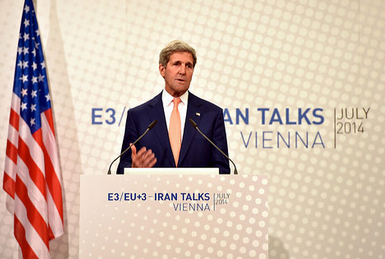We are now five days out from a July 20 deadline for a final deal over Iran’s nuclear program…and for the first time, I think we can be cautiously optimistic about the outcome.
This weekend, John Kerry joined the talks ongoing in Vienna between Iran and the Permanent five members of the Security Council plus Germany over a final agreement that would limit Iran’s capacity to build nuclear weapons in exchange for an easing of international sanctions. The negotiations are technically and politically complex. But with less than a week from the deadline there are a few reasons to be hopeful for a positive outcome.
Iran’a foreign minister Mohammad Javad Zarif gave an extended interview to the New York Times in which he outlined Iran’s current negotiating position. It satisfies many of the American demands, with the exception that all of Iran’s centrifuges would remain intact. (The USA fears that without dismantling centrifuges, Iran still has a breakout capacity should they decide to walk out on the deal.) Still, the proposal Zarif describes would effectively halt any new development of its nuclear program—which essentially extends the interim deal struck last November.
But Mr. Zarif’s decision to go public with the proposal in a 45-minute conversation before meeting with Mr. Kerry for a second time in two days was clearly tactical. His willingness to move away from Iran’s insistence that it must be free, immediately, to expand its nuclear program may give Mr. Kerry room to recommend to President Obama that the negotiations continue, for weeks or months.
Mr. Zarif’s plan follows a declaration by Iran’s supreme leader, Ayatollah Ali Khamenei, last week that Iran would not dismantle any of its infrastructure under Western pressure, but would not need a major expansion of its fuel-making facilities for at least five years. That gave Mr. Zarif, who is viewed with suspicion by Iran’s military and its clerical leadership, some wiggle room. His proposal for a freeze moves significantly in the direction that the United States and the five other nations have been urging, and brings into focus the outlines of a possible deal, though one that would be extraordinarily hard to reach by Sunday.
In a press availability earlier today in Vienna, John Kerry did not respond specifically to Zarif’s proposal. But he did cite “tangible progress.”
As I have said, and I repeat, there has been tangible progress on key issues, and we had extensive conversations in which we moved on certain things. However, there are also very real gaps on other key issues. And what we are trying to do is find a way for Iran to have an exclusively peaceful nuclear program, while giving the world all the assurances required to know that Iran is not seeking a nuclear weapon.
I want to underscore: These goals are not incompatible. In fact, they are realistic. But we have not yet found the right combination or arrived at the workable formula. There are more issues to work through and more provisions to nail down to ensure that Iran’s program will always remain exclusively peaceful. So we are going to continue to work and we’re going to continue to work with the belief that there is a way forward.
But – and this is a critical point – while there is a path forward, Iran needs to choose to take it. And our goal now is to determine the precise contours of that path, and I believe we can.
If a deal is to be struck, it will probably be struck around 11:59 on Sunday night. There is also a decent chance that sides will mutually agree that they need more time, in which case we can expect a delay. But at this point it does not look like these talks will end in total failure. And that is a positive development.
For an inside look at these negotiations, check out this recent Global Dispatches Podcast episode with journalist Laura Rozen and Daryl Kimball of the Arms Control Association.
